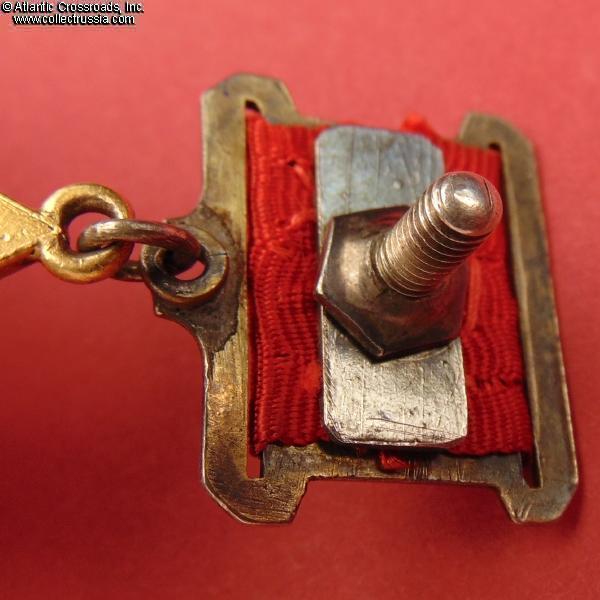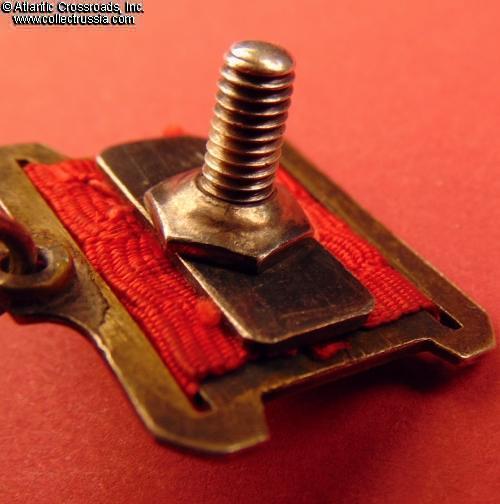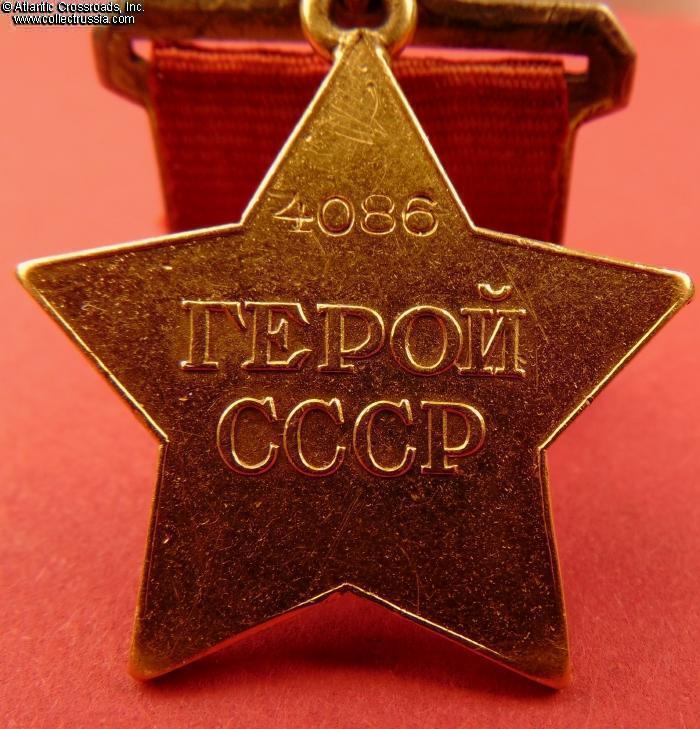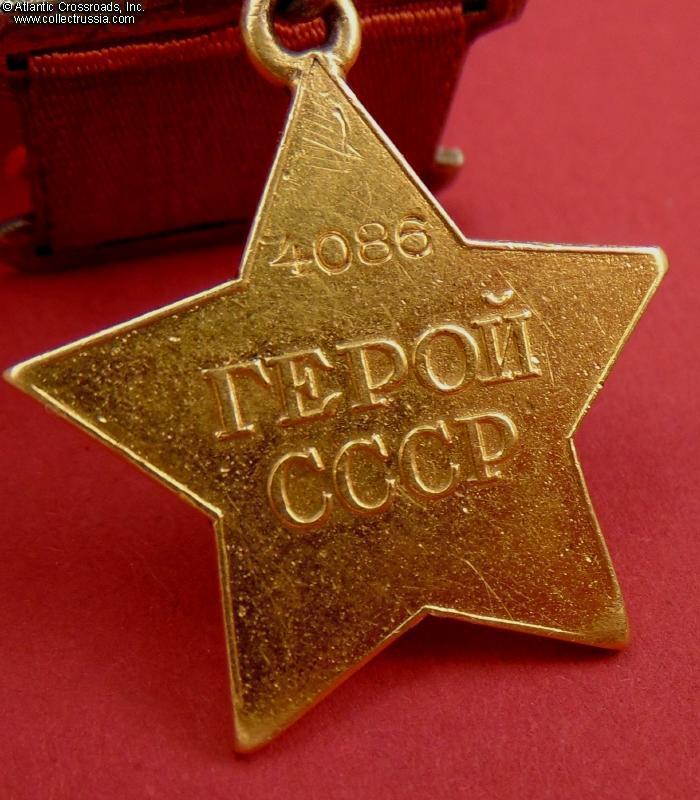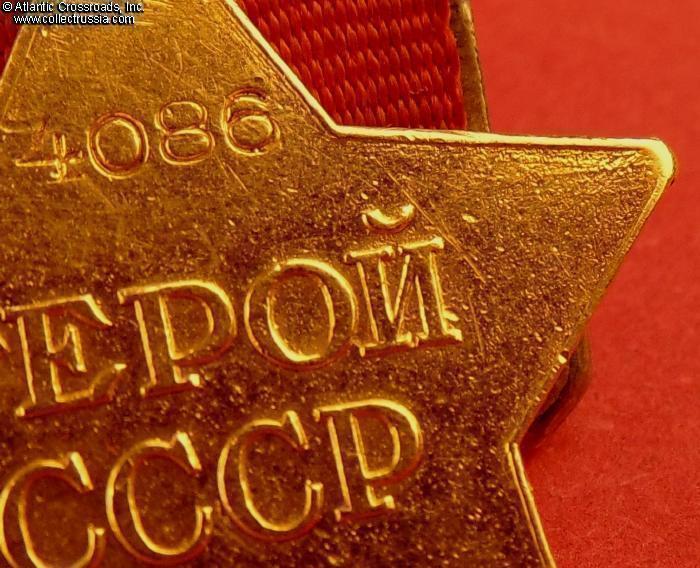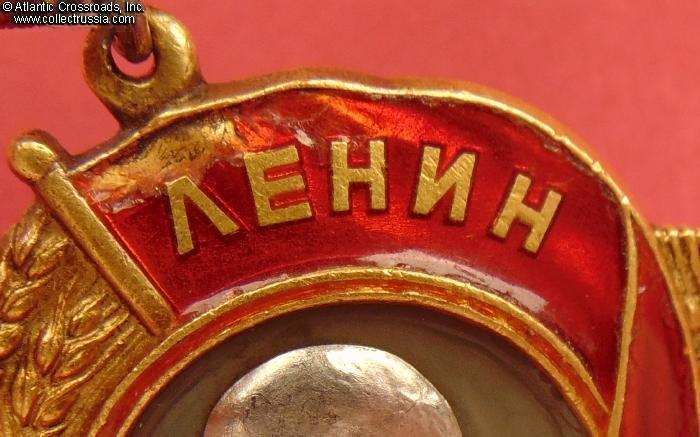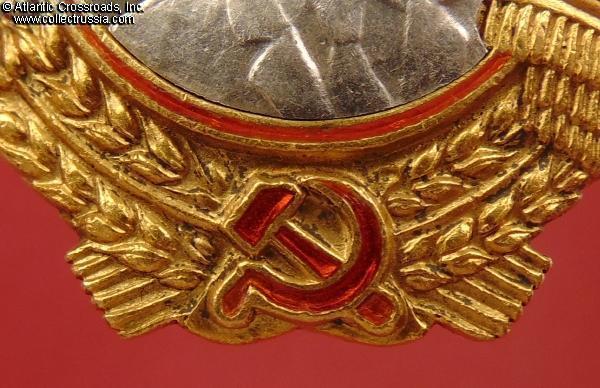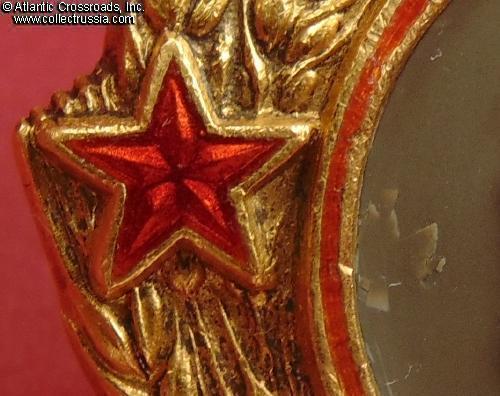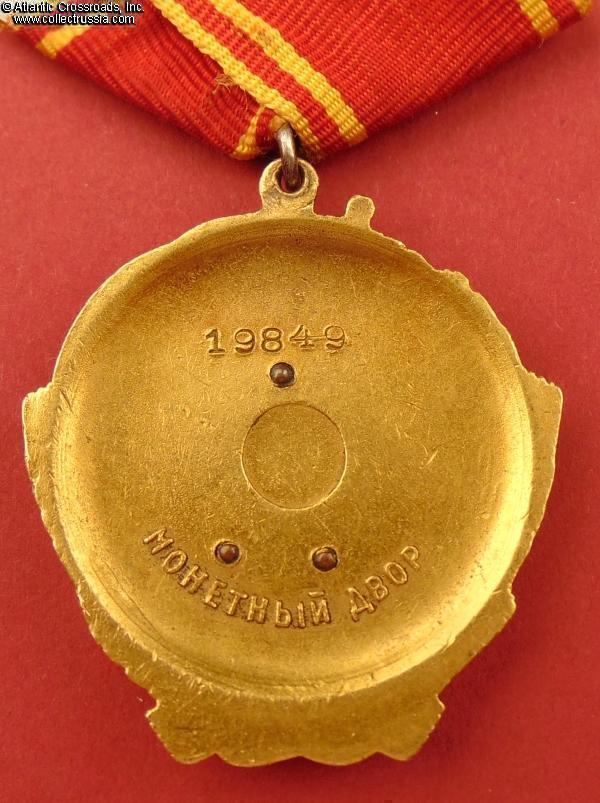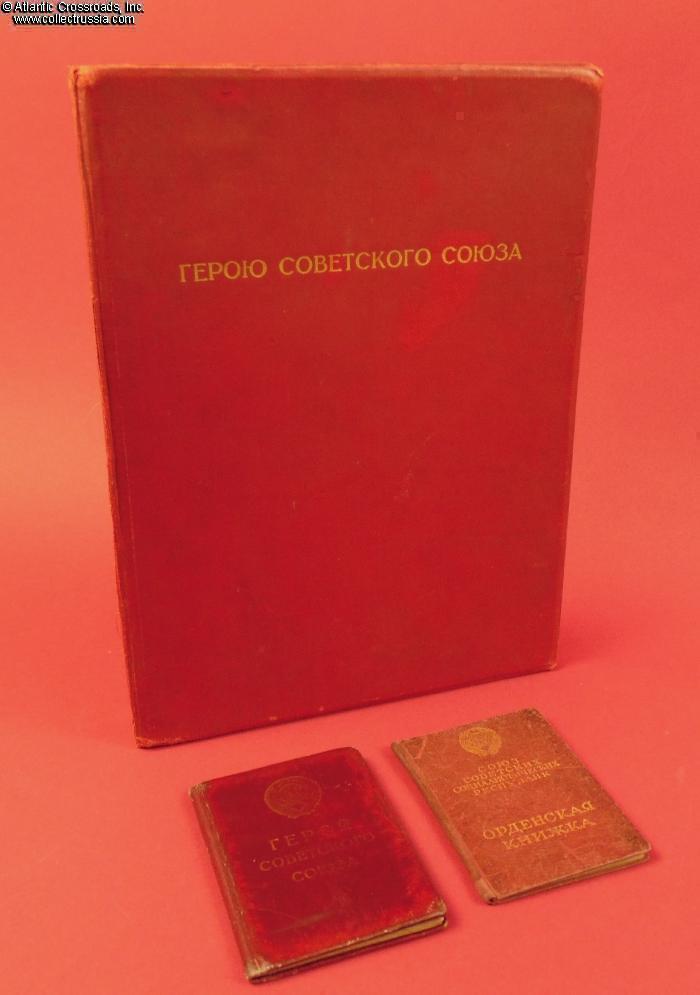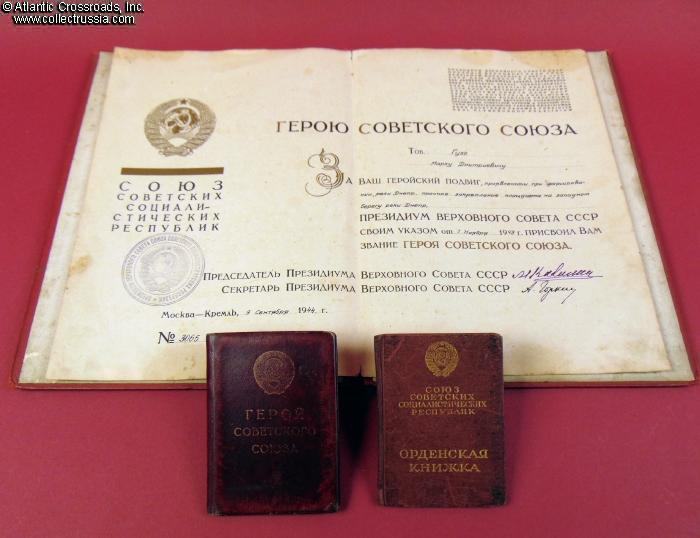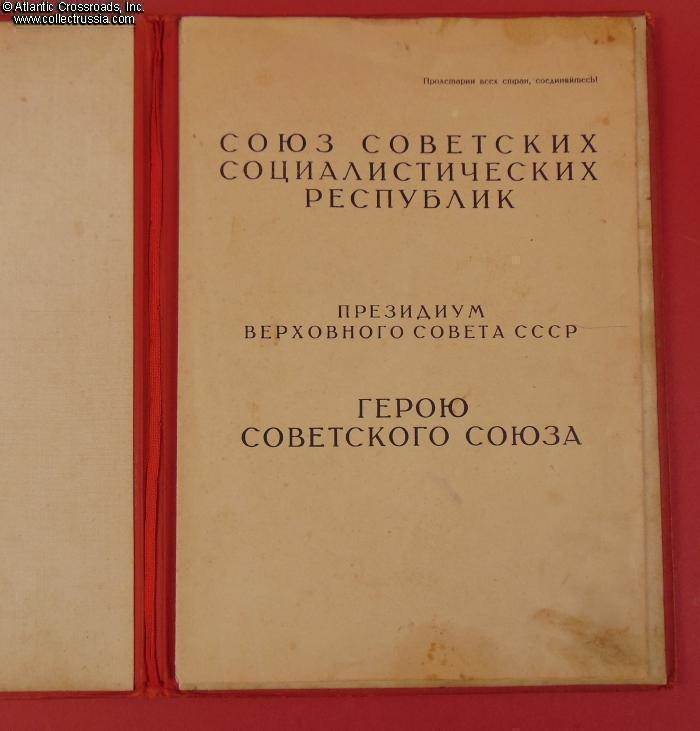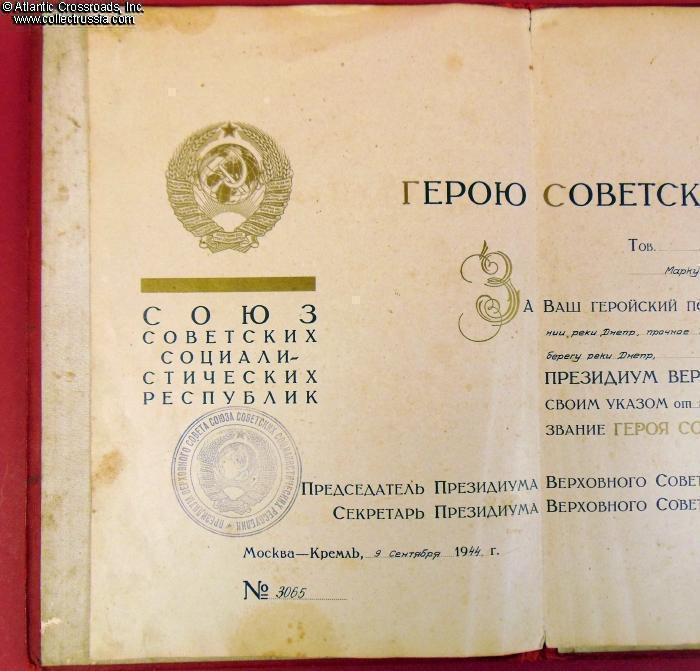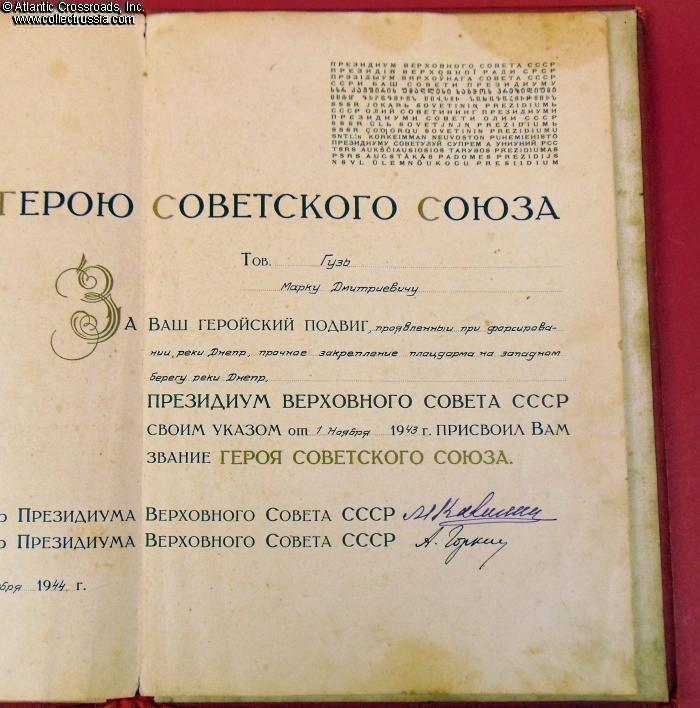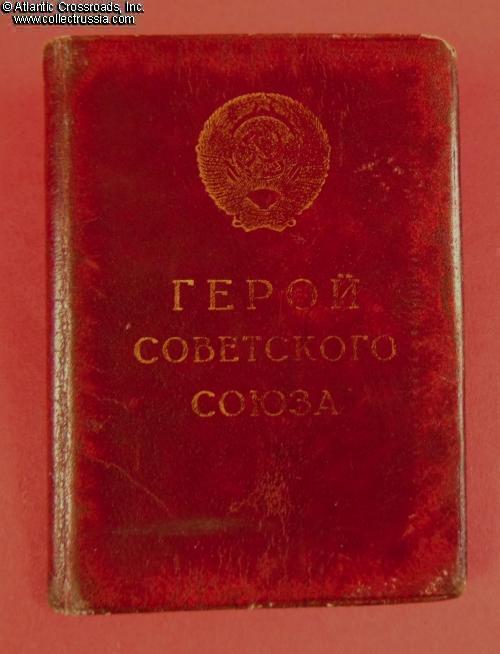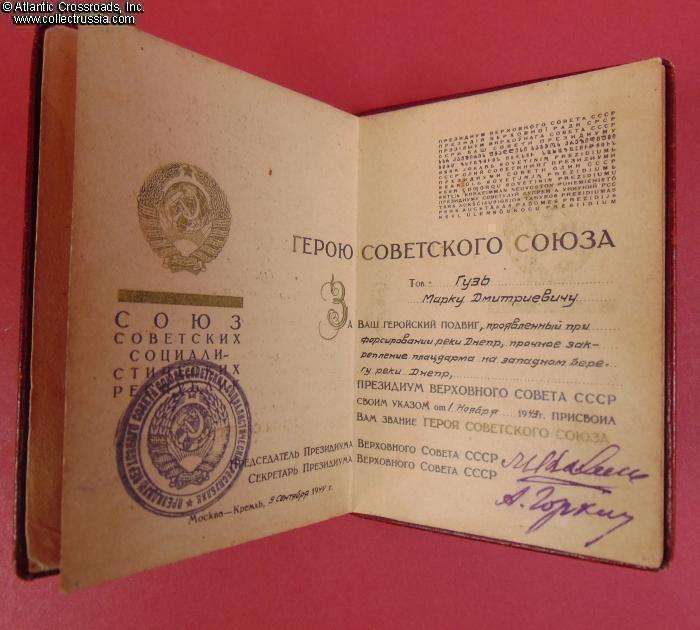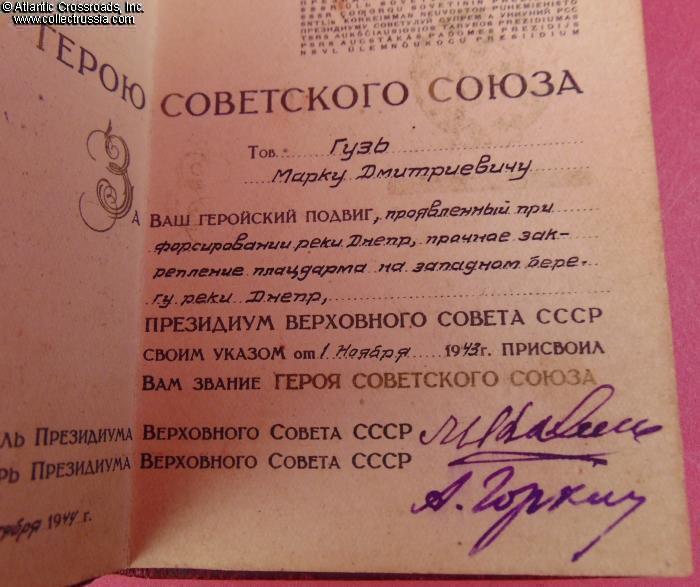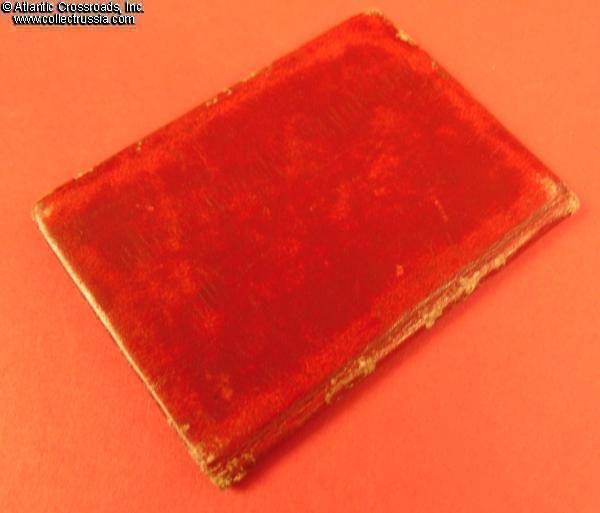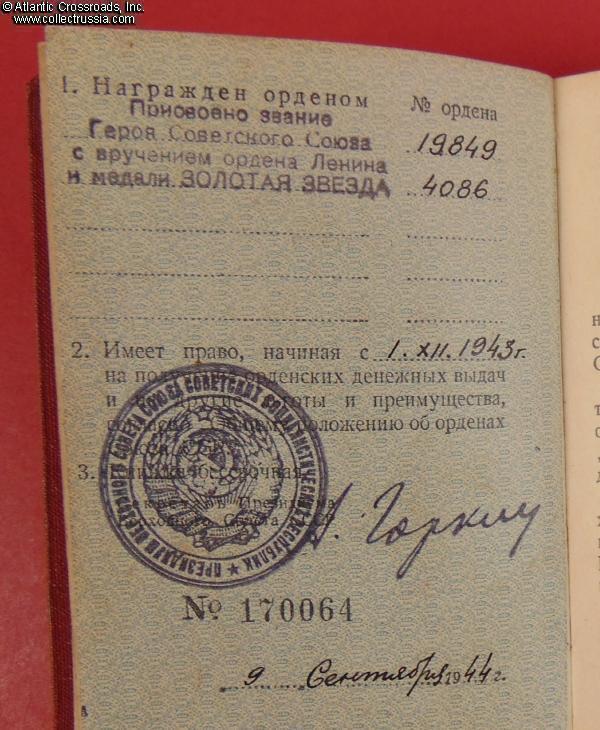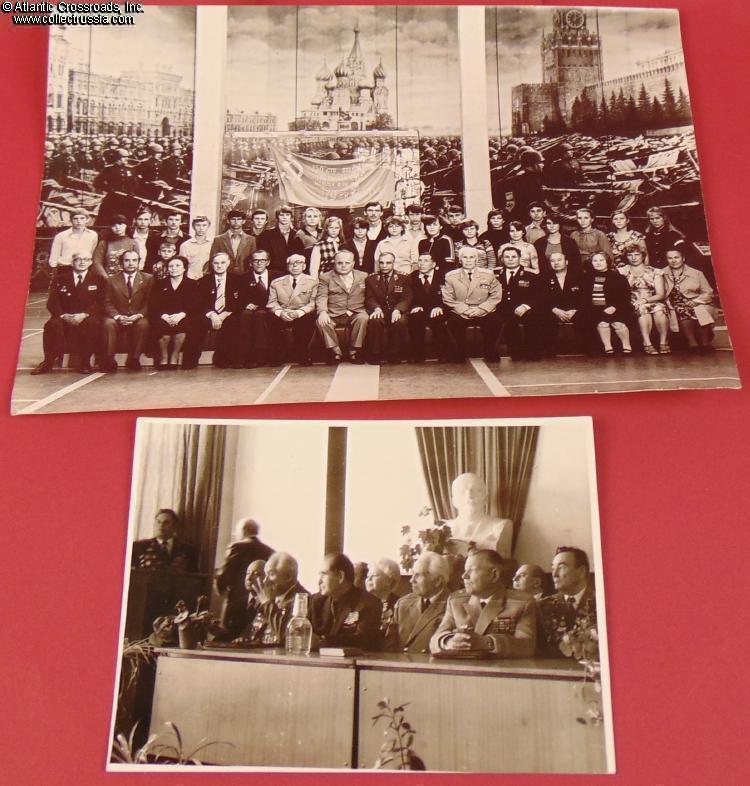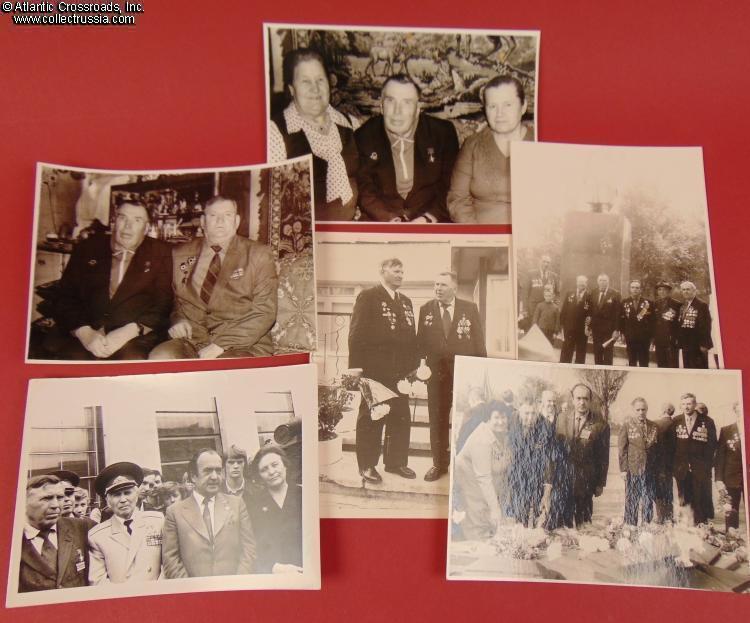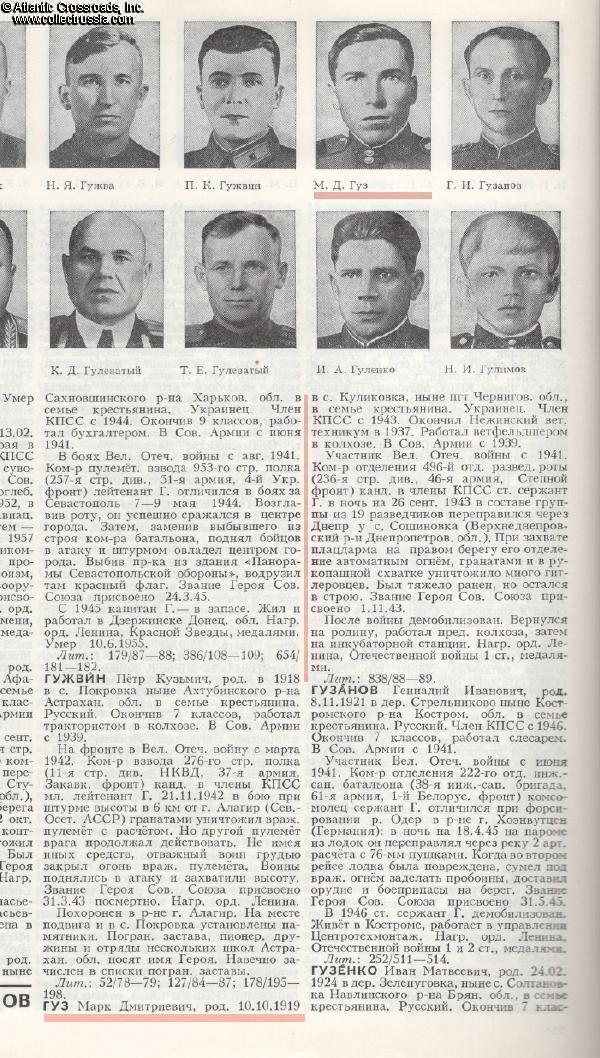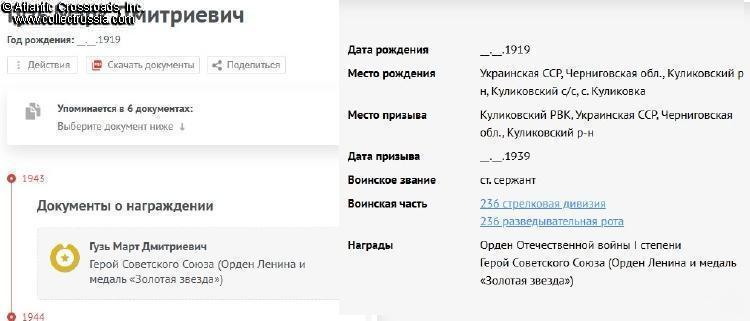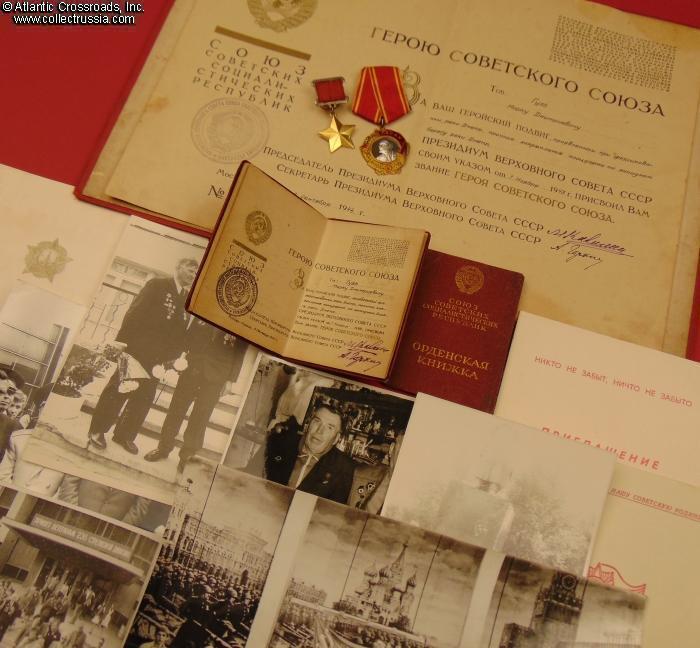
Complete Group of Two Decorations, Six Documents and Nine Photos of Hero of the Soviet Union Senior Sergeant Mark Guz (Марк Дмитриевич Гузь), Squad Commander, 496th Separate Reconnaissance Company, 236th Rifle Division, 46th Army, Steppe Front.
Gold Star Medal of a Hero of the Soviet Union, #4086. The medallion is in 23 K gold; measures 32.0 mm in height (incl. eyelet), 30.1 mm in width; weighs 19.7 g not including the suspension and connecting link. The suspension is in silver gilt, measuring 21.7 mm in height (not including the projection for the connecting link), 26.3 mm in width. Total weight of the medal with suspension and screw plate is 32.2 g.
The medal is in very fine to excellent overall condition, far better than the average for a Gold Star. The star medallion is extremely well preserved. Its ape
Gold Star Medal of a Hero of the Soviet Union, #4086. The medallion is in 23 K gold; measures 32.0 mm in height (incl. eyelet), 30.1 mm in width; weighs 19.7 g not including the suspension and connecting link. The suspension is in silver gilt, measuring 21.7 mm in height (not including the projection for the connecting link), 26.3 mm in width. Total weight of the medal with suspension and screw plate is 32.2 g.
The medal is in very fine to excellent overall condition, far better than the average for a Gold Star. The star medallion is extremely well preserved. Its apex and ridges are beautifully defined, showing almost none of the usual wear. There are some tiny contact marks on the obverse and a few minor dings, but the facets are very smooth, free of significant scratches, nicks or any other noticeable damage. The tips of the star have only a very modest amount of wear on the reverse. The reverse shows tiny contact marks and scuffs from normal wear but no significant flaws, but the stippling and lettering are overall well preserved allowing full view of the "idiosyncrasies" of the die that are a requisite of the original piece. The raised border is nicely defined as well.
The medal comes on the original suspension device, complete with its rectangular back plate, hexagon nut and mint-marked wartime screw plate. The original fire gilt finish is present on all parts of the suspension, although partly obscured by silver patina. Due to the weight of the medallion and friction with the connecting link, the bottom portion of the suspension has thinned out and has been strengthened by an addition of a small silver band of silver to the ring hole on the reverse of the suspension. The repair was done very professionally and is not visible from the obverse.
The screw post is full length, approx. 10 mm measured from the rectangular back plate. The ribbon is old, quite possibly original to the medal, but sound and clean. The connecting link is probably a replacement, although its ends are neatly soldered. To reiterate, this Hero Star is far better preserved than typical for this decoration.
Order of Lenin, Type 5, Variation 1, #19849. The medallion is in solid 23 K gold, platinum and enamels. Measures 42.8 mm in height (incl. the eyelet), 38.3 mm in width; weighs 32.7 g not including the suspension and connecting link. Features a rounded medallion and circular depression to the reverse. Note the serial number which is extremely low for the suspension type and is just below the serial number range for the "No Dimple" Variation 2 (vast majority of the wartime issues of Variation 1 have serial numbers in the range starting from approx. 27,000).
In fine to very fine condition, respectable for a relatively early wartime issue and especially one that accompanied a Hero Star. The enamel has a single relatively small chip as well as some flaking and hairlines at the upper edge under the eyelet, extending from the upper left corner to the letter "H". There are also some minuscule, barely noticeable surface flakes along the edges elsewhere, mostly on the lower fold of the banner. Most of the enamel on the banner is nevertheless intact and free of significant wear or rubbing, still exhibiting a nice luster. The red enamel on the star, red band around the medallion, and the hammer & sickle emblem has only some microscopic contact marks and appears perfect to the unaided eye. The grey enamel on the background is pristine.
The platinum bas-relief and golden wreath are free of wear visible without magnification; the raised details are perfect and crisp. The rivets are tight. Comes on a WW2-era suspension device, a two-layer model in steel with self-locking pin. The nicely preserved ribbon is old, possibly original to the decoration. The connecting link appears to be original as well, and its ends are still joined with solder.
Order Booklet, #170064, filled-out on 9 September 1944. The Hero Star and Order of Lenin issued in it are the only decorations listed in the document, which makes the group complete (this is also confirmed by the archival records.) Note that the hand-written entries are in a beautiful calligraphy of so-called "Kremlin style".
The document is in superb condition. There is only a very minimal wear to the cloth cover; the binding is perfectly tight. The internal pages are crisp and clean, completely free of the usual soiling or stains.
Hero's ID (aka "Small Certificate" for the Title of Hero) issued on 9 September 1944. The booklet is bound in fine quality leather with a Soviet state seal and writing "Hero of the Soviet Union" on the cover. Although there is a space provided for a photo of the recipient, the document never had a photo and has in its place the usual stamp "valid without a photograph". The main pages show the date of the award, 1 November 1944, as well as a citation from the Presidium of the Supreme Soviet: "For your heroic deed performed during the forced crossing of the Dnieper River (and) establishing a firm bridgehead on its right bank." The document is hand-signed by Mikhail Kalinin, Chairman of the Presidium of the Supreme Soviet of the USSR (nominally, the head of state), and Aleksandr Gorkin, Secretary of the Presidium.
The Hero's ID is in very good to excellent condition, uncommon for the documents of this type. The leather binding shows only a minor amount of wear at the spine and corners, while retaining its vibrant color and "healthy" overall appearance. A fair amount of gold in the impressed inscription "Hero of the Soviet Union" is still present. The binding is tight. The internal pages are very clean, showing only the mild age toning, no foxing, soiling, significant stains or fingerprints. All the other pages are present and free of tears, and soundly attached. Note that the "Small Hero Document" was supposed to be used as an ID to prove a Hero status. Many of the original owners carried their Hero IDs almost at all times to claim numerous privileges, and it is therefore rare to see such documents in condition as good as the example included in the group.
Large Certificate for the Title of Hero of the Soviet Union, #3065, issued on 9 September 1944. The document is enclosed in an 8 ½ " by 12" leatherette folder with the gold impression "To Hero of the Soviet Union" on the cover. The internal pages contain the same citation for crossing the Dnieper as the "Small Certificate" above. Just like the latter, the large document shows the date of the award decree and is hand-signed by Mikhail Kalinin and Aleksandr Gorkin. Also included is a notarized copy of the large certificate made in the city of Chernovtsy on 23 May 1984.
The large certificate is in very good condition. The hard cover shows a moderate amount of wear to the corners and spine but remains sound and attractive. The impressed gold writing is beautifully bright. The internal pages are free of significant wear and have only very minor tears on the edges at the fold; there is a relatively minor amount of soiling and some light stains, mostly on the title page, none of it affecting the printed and hand-written text or signatures. The gold impression of the Soviet state emblem is bold and bright.
Personal Greetings on Occasion of the 40th Anniversary of Victory over Germany, 1985. Large size, two-page document, 8"x11.5" format. The text thanks Mark Guz for his contribution to victory as well as his "labor, tireless heart, energy and optimism." Hand-signed by the director, party chief and chairman of the trade union where he worked. Excellent condition; very clean and shows only minor wrinkles, no significant wear.
Personal Greetings from the Military Council of Kiev Military District on Occasion of the 40th Anniversary of Victory over Germany, May 1985. Two-page document, approx. 6"x8.5" format. Nice artwork with the Order of the Patriotic War on the cover and motto "For Our Soviet Motherland!" Hand-signed by Commander of Kiev Military District Col. General Osipov and Chief of the Political Department of the District Lieut. General Arapov. Excellent condition.
Personalized Invitation to a Meeting of Veterans of the 236th Rifle Division to be held in the city of Krasnodar on 11-13 February 1988. The document is dated 4 January 1988. Two pages, approx. 6"x8", showing the mottos "No One is Forgotten, Nothing is Forgotten" and "They Fought for the Motherland". The typed text specifies that the meeting has been approved by the Krasnodar party and executive committees. There is an additional insert instructing the recipient of the letter to have 5-7 rubles of spending money to cover the bus fare and contribute to the purchase of the wreaths to be laid at the Lenin monument and WW2 memorial. It further advises to give advance notice of travelling plans so that the train or airplane tickets (ever a problem in the Soviet Union) could be booked by the event planning board. The document has been folded in two horizontally and has a minor graphite smear on the cover, otherwise perfect.
Nine Large Format b/w Photos of the Recipient and His Comrades-in-Arms. All photos were taken in the post-war years, mostly at veteran meetings and WW2 commemorative events. All are in excellent condition. The photos are as follows:
1. Very large Group Portrait Photo of veterans of the 236th Rifle Division, dated 27 July 1983. Approx. 7.5" x 11.5" format. The inscription on the verso specifies that the photo was taken at the regiment's veteran reunion in the Central Museum of the Armed Forces in Moscow. The highly decorated veterans - a few of them Heroes of the Soviet Union - and their spouses are sitting in the first row; standing behind them are students of the Dnepropetrovsk Machine-building Technical College, WW2 history enthusiasts, who were in attendance. Each of the 15 people in the first row is identified with his or her rank and specific position in the unit, where applicable. Mark Guz is ninth from the left (his last name is misspelled "Giz" on the verso), right next to the division commander Twice Hero of the Soviet Union Maj. Gen. Fesin on his left (right to the viewer).
2. Photo showing Guz, his former division commander Fesin, and two other veterans, taken at the July 1983 meeting. This and the other photos mentioned below are of 7"x5" format. The man and woman on the right are also shown and identified in the group portrait above. They are Corp. Viktor Boichenko, who served with Guz in the same recon detachment and earned the Title of Hero in the same action, and Elena Tarakanova, a 236th Rifle Div. medic who took part in the battle for the Dnieper River bridgehead alongside Guz. The photo is inscribed by Boichenko "My dear friend and comrade in arms Mark! With great joy I am sending you this and the other photos as a memento of our meeting in Moscow on 27.VIII.83, especially (notable) because (it took place) under the combat banner of our 236th Rifle Division. It was very good that you came over. Hugging you! Yours, Viktor B."
3. Photo inscribed on verso "6 April 1985. SPTU (Special Technical Trade School) #113, the location of the 46th Army Museum. Comrade Aleksandr Matveevich Kolesnikov is making a speech."
4. Photo of Guz in a large group of veterans leaving a public building, likely a school. There is a banner "Greetings to the Veterans of the 236th Rifle Division" over the front entrance.
5. Guz, Boichenko and a group of other veterans laying flowers at a WW2 eternal flame memorial.
6. Guz and several other highly decorated veterans in front of what appears to be a Lenin's monument.
7. Guz and an unidentified WW2 veteran, both with full chest of decorations on their "Sunday best" and holding bouquets of chrysanthemums.
8. Photo of Guz and two female family members or friends, apparently taken at his or his friend's home, 1985-1990.
9. Photo of Guz and another decorated WW2 veteran, probably a close friend. This photo was apparently taken on the same day and in the same location as the one above.
Mark Guz was born in 1919 to a peasant family in a village of the Chernigov region of Ukraine. In 1937, he graduated from a veterinary medicine college and then for two years worked as a veterinarian at a collective farm. In 1939, he was drafted into the Red Army and was still on active duty at the beginning of the Patriotic War in 1941. As of the fall of 1943, Guz had the rank of Senior Sergeant and was serving as a squad commander with the 496th Separate Reconnaissance Company, 236th Rifle Division, 46th Army, Steppe Front.
Following the victory in the Battle of Kursk and the first successful Soviet summer offensive of the war, the 46th Army had reached the Dnieper River. With its wide span and high western banks, the Dnieper presented the most formidable water barrier on the path to the central part of Europe, and the German high command had put great hopes in stopping the Soviet advance there and then. The Germans however had been far too slow in building up the much publicized "East Wall" along the river and got caught flat footed by the speed of the Soviet rush to the Dnieper.
The great battle for the Dnieper River line that unfolded starting from September 1943 is far less known in the west than some other battles of the Eastern Front such as Stalingrad, Kursk and Berlin. It was however always considered to be of equal importance by Soviet and Russian historians. At the time of the battle, Soviet high command spared no resources in creating multiple bridgeheads on the western bank as quickly as possible and without preparation, before the Germans had a chance to dig in. In an unprecedented move, Stalin promised a Hero Star to any soldier who would be among the first to capture and hold a bridgehead - a nearly suicidal task. The mass movement of troops across the river using all means of floatation began immediately. On 22 September, the first tenuous bridgehead was established near Bukrin south of Kiev by a group of four submachine gunners, followed first by a rifle company and then an entire tank army. Within four days, several more bridgeheads appeared along the 100-mile stretch of the Dnieper between Kremenchug and Dnepropetrovsk. These would soon expand and merge, creating a significant jumping off position for the further offensives into central and western parts of Ukraine.
Mark Guz was responsible for creating one of these first bridgeheads. During the night of 25-26 September, he with a group of 18 scouts embarked on boats near the village of Soshinovka in the Verkhnedneprovskiy District, Dnepropetrovsk Region. Despite the Germans keeping the river under searchlights, they almost managed to cross undetected but were spotted a few meters away from western bank. As a torrent of fire unfolded around them, Guz commanded his men to jump into the water and swim to the shore. Minutes later, they were on dry land and immediately attacked the nearest enemy outpost.
In a fierce skirmish, Guz and his squad fought with submachine guns, grenades and hand-to-hand, eliminating scores of German soldiers. Guz personally killed seven after jumping into an enemy trench. As the surviving Germans took flight, he and his team spread out further from the river and took a defensive position. Two hours later, the Germans launched a counterattack that was repelled by the Soviet scouts. In the second counterattack, Guz was severely wounded but kept on fighting and with his men repulsed yet another counterattack. By that point, he had lost a lot of blood and was offered to be evacuated to a field hospital on the east bank. Instead, he insisted on staying with his men until the entire division crossed the river thus ensuring that the bridgehead would be held fast.
True to the promise, on 1 November 1943, the Presidium of the Supreme Soviet of the USSR made Sr. Sgt. Guz a Hero of the Soviet Union - one of some 2000 people awarded with the highest Soviet title of recognition for the forced crossing of the Dnieper. It is not clear what happened in the immediate aftermath of the battle, but through the end of the war Guz received no other decorations beside the Hero Star and Order of Lenin that came with it (his only other decoration was the "jubilee" Order of the Patriotic War, 1st cl. awarded in 1985). Judging by that, it seems likely that the wound he suffered in combat on the Dnieper bridgehead precluded him from further frontline service. He did however remain on active duty in the military and got discharged only after the end of the war. He then returned to his native village of Kulikova in the Chernigov region where he became the chairman of a collective farm and in later years of his life, worked at a chicken breeding farm. He passed away in 1990.
Research Materials: Xerox copy and translation of the article about Guz in the official Soviet-era catalog Heroes of the Soviet
Union
(contains his photo). Additional information about him can be found on several Russian-language websites such as warheroes.ru.
$29,500.00 Add to cart












